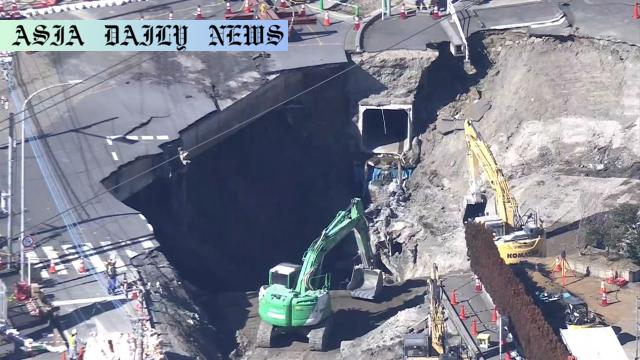Sinkhole: Rescuers struggle to recover missing man after truck falls into massive 15m-deep sinkhole; challenges include sewage water and toxic gas.

Massive Sinkhole Sparks Tragedy in Saitama
A major disaster has unfolded in Yashio City, Saitama Prefecture, as rescue teams continue their efforts to locate a missing 74-year-old man. The man disappeared after his truck fell into a massive sinkhole at a busy intersection on January 28. The sinkhole, now approximately 15 meters deep, has flooded with what is believed to be sewage water and has become clogged with concrete debris and other materials.
Discovery of a Possible Lead
On Wednesday, rescue officials monitoring the area with drones spotted what seemed to be the partially submerged cab of the man’s truck. The object, resembling a whitish chunk of metal, was detected within a sewage pipe located 100 to 200 meters downstream from the site of the road collapse. However, due to poor visibility and hazardous conditions, it remains unclear whether the driver is inside the vehicle.
The Challenges of Sewage and Toxic Hazards
The rescue teams face significant obstacles in their search. The sewage pipe where the truck was located has high-speed water flow, which makes navigating the confined spaces particularly dangerous. Additionally, the presence of hydrogen sulfide, a highly toxic gas, has increased the risks for the responders attempting to gain access. These issues complicate an already difficult retrieval mission, requiring expert guidance and specialized equipment.
Collaborating for Solutions
The Saitama Prefectural Government is consulting fire department specialists, engineers, and Japan’s Self-Defense Forces to determine the safest and most effective course of action. Evaluating structural risks and the potential for further collapses is a priority, as is ensuring the safety of search personnel. Efforts are also underway to devise contingency plans in case of additional flooding or gas emissions.
Community Reaction and Broader Implications
The community of Yashio City has been deeply affected by the tragedy, with many residents expressing concerns about infrastructure safety and preparedness for future natural disasters. Authorities are investigating the cause of the sinkhole, with early theories suggesting a combination of aging sewage systems and heavy rainfall. This incident has sparked discussions in Japan about the importance of modernizing urban utilities to prevent similar occurrences.
Hope Amidst Challenges
Despite the daunting conditions, rescue teams remain committed to their mission. While time is of the essence, they are balancing the importance of thorough planning with the urgency of finding the missing individual. The situation serves as a grim reminder of the unpredictable dangers that infrastructure failures can pose, and highlights the indispensable role of emergency response teams in mitigating such crises.
Preparing for the Future
This tragic event underscores the need for improved urban planning and emergency readiness. Beyond the immediate rescue operation, officials are calling for comprehensive reviews of municipal systems across Japan to identify vulnerable areas. By addressing systemic weaknesses now, authorities aim to minimize potential risks and safeguard communities in the years to come.
Commentary
The Human Cost of Sinkhole Tragedies
The recent sinkhole in Saitama is a heartbreaking reminder of the vulnerabilities in our infrastructure, which can have devastating consequences for individuals and their families. The disappearance of a 74-year-old driver underscores the need for robust safety measures and the importance of maintaining critical infrastructure systems, particularly in areas prone to urban development or natural wear and tear.
The Challenges Faced by Rescue Teams
Rescue operations in sinkhole disasters are among the most complex and dangerous endeavors. Crews not only contend with debris and unstable ground but, as in this case, face additional hazards like flooding and toxic gases. The presence of hydrogen sulfide makes the task particularly hazardous, requiring specialized knowledge and equipment. These challenges highlight the need for advanced training and inter-departmental coordination for emergency responders.
Call to Modernize and Prevent Future Risks
While the immediate focus is on finding the missing individual, this incident reveals broader systemic issues in urban planning and infrastructure maintenance. In rapidly urbanizing regions like Saitama, older sewage systems and aged construction are proving inadequate against modern challenges such as extreme weather and population density. Japan, like many industrialized nations, must take proactive steps to audit and modernize its critical infrastructure to prevent future tragedies of this nature.
A Hopeful Future
As authorities and rescue teams collaborate on this operation, there is hope that lessons learned will translate into practical solutions. The world will be watching Japan’s response, not only as an example of crisis management but as an opportunity to inspire change and prioritize infrastructure safety for generations to come.


